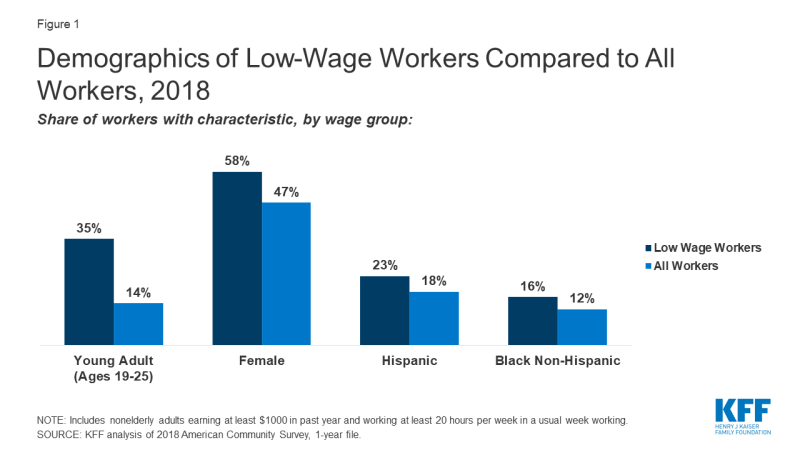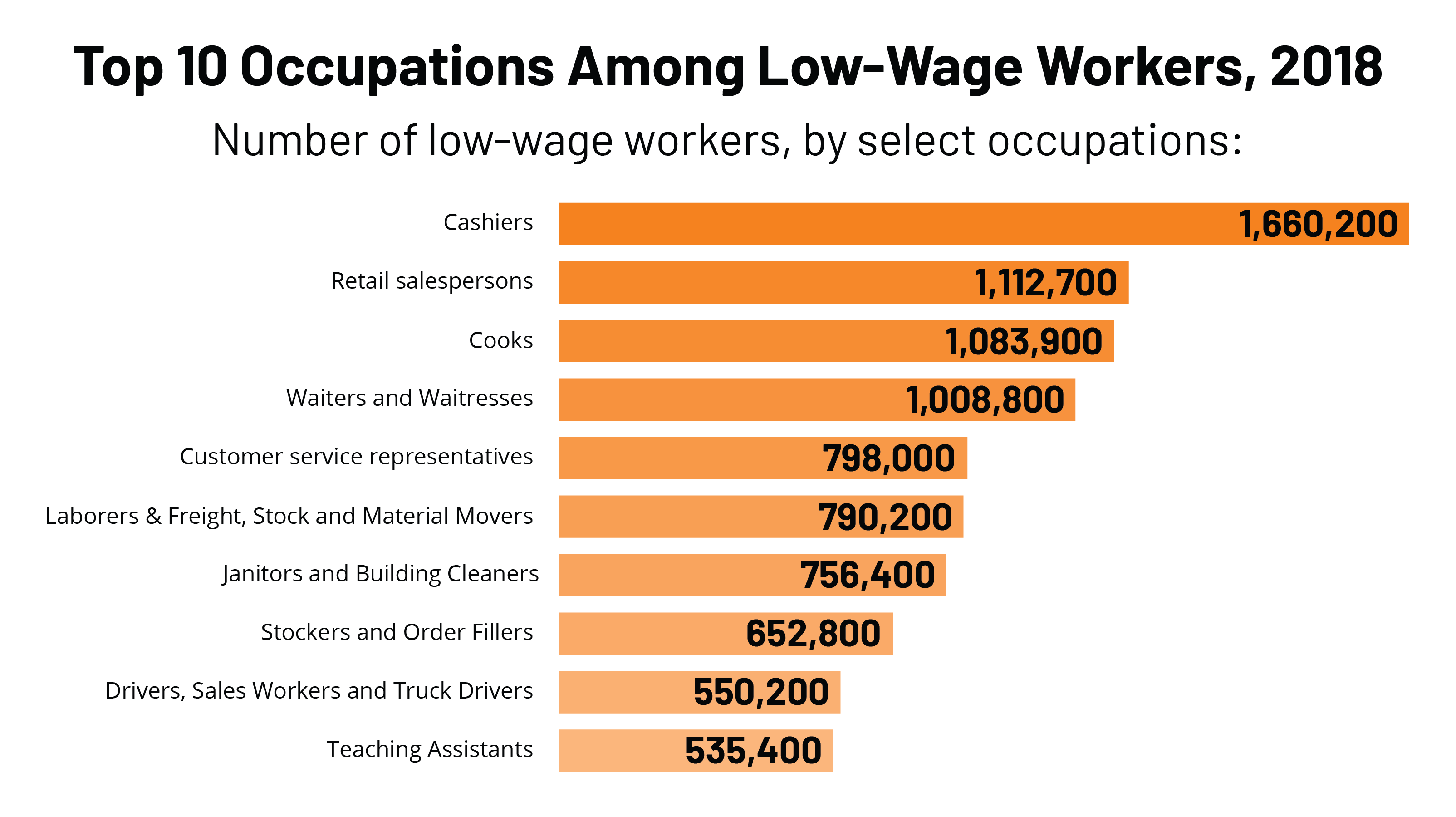What’s the big “hubbub” over raising the minimum wage to $15/hour? After all, the last time the U.S. lifted the minimum wage was in 2009. The argument for increasing the minimum is to create a “livable wage” for those working at that level. However, is that the best way to help “the poor?”
The Biden Administration wants to include an increase of the minimum wage in the proposed “Infrastructure” plan. Many may forget the attempt to hike the minimum wage during his tenure as Vice-President with the Obama Administration. At that time, there was such an immense level of table-pounding you would assume a majority of Americans got trapped at minimum wage. However, let’s take a look at some numbers.
How Many Work For Minimum Wage?
According to the latest available annual data from the Bureau Of Labor Statistics:
“In 2019, 82.3 million workers age 16 and older in the United States were paid at hourly rates, representing 58.1 percent of all wage and salary workers. Among those paid by the hour, 392,000 workers earned exactly the prevailing federal minimum wage of $7.25 per hour. About 1.2 million had wages below the federal minimum.
Together, these 1.6 million workers with wages at or below the federal minimum made up 1.9 percent of all hourly paid workers.”
Notably, that 1.9% of minimum wage, or less, workers declined 50% from the same report in April 2015:
“In 2014, 77.2 million workers age 16 and older in the United States were paid at hourly rates, representing 58.7 percent of all wage and salary workers. Among those paid by the hour, 1.3 million earned exactly the prevailing federal minimum wage of $7.25 per hour. About 1.7 million had wages below the federal minimum.
Together, these 3.0 million workers with wages at or below the federal minimum made up 3.9 percent of all hourly-paid workers.”
Notably, this number has been reduced drastically from the 13.4% of workers earning minimum wage in 1979.
Of those 1.6 million workers, 49% were aged 19-25, according to the KFF Organization.

Not surprisingly, we primarily find these individuals in the fast food, retail, and service industries.

So What?
“So what? People working at restaurants need to make more money.”
Okay, let’s hike the minimum wage to $15/hr. That doesn’t sound like that big of a deal. Let’s do that math:
My son turned 16 last November and got his first job. He works as a “packer/runner” for a local restaurant to pack orders for pickup due to Covid-19 seating restrictions. Importantly, he has no experience. He also has no idea what “working” actually means and is about to experience the cruel joke of taxes.
However, let’s do the math of $15/hr assuming he works full-time this summer.
- $15/hr X 40 hours per week = $600/week
- $600/week x 4.3 weeks in a month = $2,580/month
- $2580/month x 12 months = $30,960/year.
Let that soak in for a minute. We are talking about paying $30,000 per year to a 16-year old to run food out to customers. (That salary would put him in the top 1% of wages earners globally.)
Now, let’s expand the math to the current situation.
- 1.9 Million Workers
- $30,960 / year (assuming all workers work full time)
- Assuming everyone worked previously at $7.50/hour
- Wages increase by $29.4 billion over the year.
An increase in wages of $29.4 billion will either get passed onto consumers at higher costs, or the number of jobs decline.
The Trickle Up Effect:
According to Payscale, the median hourly wage for a restaurant manager is $13.00 an hour.

What do you think happens when my son, with no experience, is making more than the restaurant manager?
The owner will have to increase the manager’s salary. But wait. Now the manager is making more than the district manager, which requires another pay hike. So forth, and so on.
Of course, none of this is a problem as long as you can pass on higher payroll, benefits, and rising healthcare costs to the consumer.
Small Business Already Noticing
But that is a problem already. As the National Federation Of Independent Business (NFIB) noted in a recent survey. To wit:
“Yes, injecting stimulus into the economy will provide a short-term increase in demand for goods and services. When the funds are exhausted, the demand fades. However, small business owners understand the limited impact of artificial inputs. As such, they will not make long-term hiring decisions, an ongoing cost, against a short-term artificial increase in demand.
Also, given President Biden is focused on more government regulation and higher taxes (which falls squarely on the creators of employment), increased costs will further deter long-term hiring plans.”

Such was explicitly a point made by the Congressional Budget Office as well.
“Higher wages would increase the cost to employers of producing goods and services. Employers would pass some of those increased costs on to consumers in the form of higher prices. Those higher prices, in turn, would lead consumers to purchase fewer goods and services.
Employers would consequently produce fewer goods and services. As a result, they would tend to reduce their employment of workers at all wage levels. When the cost of employing low-wage workers goes up, the relative cost of employing higher-wage workers or investing in machines and technology goes down. Some employers would therefore respond to a higher minimum wage by shifting toward those substitutes and reducing their employment of low-wage workers.”
Been Here Before
That analysis dovetailed with previous research from the Manhattan Institute when the Obama Administration tried lifting the minimum wage previously.
“By eliminating jobs and/or reducing employment growth, economists have long understood that adoption of a higher minimum wage can harm the very poor who are intended to be helped.
But this groundbreaking paper by Douglas Holtz-Eakin, president of the American Action Forum and former director of the Congressional Budget Office, and Ben Gitis, director of labormarket policy at the American Action Forum, comes to a strikingly different conclusion:
Overall employment growth will be lower as a result of a higher minimum wage. Furthermore, much of the increase in income that results for those fortunate enough to have jobs, would go to relatively higher-income households. It would not help those households in poverty in whose name the campaign for a higher minimum wage gets waged.”
Problems With Hiking The Minimum Wage
- Raising the minimum wage has a variety of effects on both employment and family income. By increasing the cost of employing low-wage workers, a higher minimum wage generally leads employers to reduce the size of their workforce.
- The effects on employment would cause changes in prices and different labor and capital types.
- By boosting the income of low-wage workers who keep their jobs, a higher minimum wage raises their families’ real income, lifting some families out of poverty. However, real income falls for some families because other workers lose their jobs, business owners lose income, and prices increase for consumers.
Net Impact
- The net effect of a minimum-wage increase is to reduce average real family income.
Minimum Wage Impact On Employment
- Higher wages increase the cost to employers of producing goods and services. The employers pass some of those increased costs on to consumers in the form of higher prices. Those higher prices, in turn, lead consumers to purchase fewer goods and services.
- The employers consequently produce fewer goods and services, reducing their employment of low-wage and higher-wage workers.
- When the cost of employing low-wage workers goes up, the relative cost of hiring higher-wage workers or investing in machines and technology goes down.
Net Impact:
- An increase in the minimum wage affects those components in offsetting ways.
- It increases the cost of employing new hires for firms
- Reduces the costs of higher-wage workers and productivity-increasing technology
- Makes firms raise wages for all current employees whose salaries are below the new minimum, regardless of whether new workers get hired.

Minimum Wage Increase Effects Across Employers
Employers vary in how they respond to a minimum-wage increase.
- Employment tends to fall more at firms whose sales decline when they raise prices. Also, at firms that can readily substitute machines or technology for low-wage workers.
- They might reduce workers’ fringe benefits (such as health insurance or pensions) and job perks (such as employee discounts). Such lessens the effect of the higher minimum wage on total compensation.
- Employers could also partly offset their higher costs by cutting back on training. They could also opt to assign work to independent contractors who the FLSA does not cover.
Net Impact
- Employers respond to higher minimum wages by cutting costs or benefits elsewhere.
Conclusion
Should we raise the minimum wage from $7.25 an hour to say $9.00 an hour? Probably. The cost of living has risen since the 2009 wage hike, and an increase would likely be more palatable than a doubling.
However, while a drastic hike to $15 sounds innocent enough, it has the most significant negative impact on the poor, as reported by the Foundation For Economic Freedom:
“Minimum wage laws create a barrier to getting a job that the privileged are better able to overcome than the underprivileged. When jobs are scarce, then immigrants, workers with few skills or little education, and those with limited English proficiency are going to have a harder time convincing employers that their labor is worth $15 an hour than their better-skilled, native, English-speaking competitors. As Thomas Leonard has recently shown, unemploying such marginalized groups are regarded as part of the point of minimum wage laws by early 20th-century ‘progressives’ who saw the minimum wage as a useful tool for keeping immigrants, blacks, and women out of the labor market.”
Notably, the unintended consequences of a minimum wage hike in a weak economic environment are not inconsequential. Given that businesses are already fighting for profitability, hiking the minimum wage, given the subsequent “trickle up” effect, will lead to further increases in productivity and a reduction in employment.


